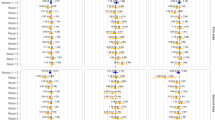Abstract
An evolving epidemic of cardiovascular disease (CVD) is having a profound effect on the health of vulnerable populations in low-to-middle income countries with limited resources. Despite some encouraging signs (particularly initiatives from the WHO), global and regional apathy towards noncommunicable forms of CVD adds to the complexity of issues to consider when establishing cost-effective prevention programs. We present our perspective on overcoming the myriad of barriers to providing cost-effective measures for CVD prevention in a resource-poor environment through the 'prism' of our experiences in establishing the Heart of Soweto Study in South Africa.
This is a preview of subscription content, access via your institution
Access options
Subscribe to this journal
Receive 12 print issues and online access
$209.00 per year
only $17.42 per issue
Buy this article
- Purchase on Springer Link
- Instant access to full article PDF
Prices may be subject to local taxes which are calculated during checkout

Similar content being viewed by others
References
World Health Organization. The global burden of disease: 2004 update. World Health Organization [online], (2008).
Fox, C. S., Evans, J. C., Larson, M. G., Kannel, W. B. & Levy, D. Temporal trends in coronary heart disease mortality and sudden cardiac death from 1950 to 1999: the Framingham Heart Study. Circulation 110, 522–527 (2004).
Stewart, S. et al. Trends in hospitalization for heart failure in Scotland, 1990–1996. An epidemic that has reached its peak? Eur. Heart J. 22, 209–217 (2001).
Jhund, P. S. et al. Long-term trends in first hospitalization for heart failure and subsequent survival between 1986 and 2003: a population study of 5.1 million people. Circulation 119, 515–523 (2009).
Abegunde, D. O., Mathers, C. D., Adam, T., Ortegon, M. & Strong, K. The burden and costs of chronic diseases in low-income and middle-income countries. Lancet 370, 1929–1938 (2007).
Yusuf, S., Reddy, S., Ounpuu, S. & Anand, S. Global burden of cardiovascular diseases: Part II: variations in cardiovascular disease by specific ethnic groups and geographic regions and prevention strategies. Circulation 104, 2855–2864 (2001).
World Health Organization. 2008–2013 action plan for the global strategy for the prevention and control of noncommunicable diseases. World Health Organization [online], (2008).
Stewart, S. et al. Mapping the emergence of heart disease in a black, urban population in Africa: the Heart of Soweto Study. Int. J. Cardiol. 108, 101–108 (2006).
Tibazarwa, K. et al. A time bomb of cardiovascular risk factors in South Africa: results from the Heart of Soweto Study “Heart Awareness Days”. Int. J. Cardiol. 132, 233–239 (2009).
Sliwa, K. et al. Spectrum of heart disease and risk factors in a black urban population in South Africa (the Heart of Soweto Study): a cohort study. Lancet 371, 915–922 (2008).
Stewart, S. et al. Predominance of heart failure in the Heart of Soweto Study cohort: emerging challenges for urban African communities. Circulation 118, 2360–2367 (2008).
Nissinen, A. et al. Community-based noncommunicable disease interventions: lessons from developed countries for developing ones. Bull. World Health Organ. 79, 963–970 (2001).
Yusuf, S., Reddy, S., Ounpuu, S. & Anand, S. Global burden of cardiovascular diseases: part I: general considerations, the epidemiologic transition, risk factors, and impact of urbanization. Circulation 104, 2746–2753 (2001).
Gaziano, T. A. Reducing the growing burden of cardiovascular disease in the developing world. Health Aff. (Millwood) 26, 13–24 (2007).
Leeder, S., Raymond, S., Greenburg, H., Liu, H. & Esson, K. A Race Against Time: The Challenge of Cardiovascular Disease in Developing Countries. (Trustees of Columbia University, New York, 2004).
Sridhar, D. & Batniji, R. Misfinancing global health: a case for transparency in disbursements and decision making. Lancet 372, 1185–1191 (2008).
Howson, C. P. for the Committee on Research, Development, and Institutional Strengthening for Control of Cardiovascular Diseases in Developing Countries. Control of Cardiovascular Diseases in Developing Countries: Research, Development, and Institutional Strengthening (National Academies Press, Washington, 1998).
Jamison, D. et al. Disease Control Priorities in Developing Countries (Oxford University Press and the World Bank, New York, 2006).
Group, I. C. R. Intersalt: an international study of electrolyte excretion and blood pressure. Results for 24 hour urinary sodium and potassium excretion. Br. Med. J. 297, 319–328 (1988).
Rose, G. The Strategy of Preventive Medicine (Oxford University Press, New York, 1992).
Jackson, R. Updated New Zealand cardiovascular disease risk-benefit prediction guide. Br. Med. J. 320, 709–710 (2000).
Gaziano, T. A., Steyn, K., Cohen, D. J., Weinstein, M. C. & Opie, L. H. Cost-effectiveness analysis of hypertension guidelines in South Africa: absolute risk versus blood pressure level. Circulation 112, 3569–3576 (2005).
Gaziano, T. A., Young, C. R., Fitzmaurice, G., Atwood, S. & Gaziano, J. M. Laboratory-based versus non-laboratory-based method for assessment of cardiovascular disease risk: the NHANES I Follow-up Study cohort. Lancet 371, 923–931 (2008).
Wald, N. J. & Law, M. R. A strategy to reduce cardiovascular disease by more than 80%. Br. Med. J. 326, 1419 (2003).
Gaziano, T. A., Opie, L. H. & Weinstein, M. C. Cardiovascular disease prevention with a multidrug regimen in the developing world: a cost-effectiveness analysis. Lancet 368, 679–686 (2006).
Author information
Authors and Affiliations
Corresponding author
Rights and permissions
About this article
Cite this article
Stewart, S., Sliwa, K. Preventing CVD in resource-poor areas: perspectives from the 'real-world'. Nat Rev Cardiol 6, 489–492 (2009). https://doi.org/10.1038/nrcardio.2009.79
Issue Date:
DOI: https://doi.org/10.1038/nrcardio.2009.79
This article is cited by
-
Exploring stakeholders’ perceptions of a task-shifting strategy for hypertension control in Ghana: a qualitative study
BMC Public Health (2017)
-
Forgotten cardiovascular diseases in Africa
Clinical Research in Cardiology (2010)



